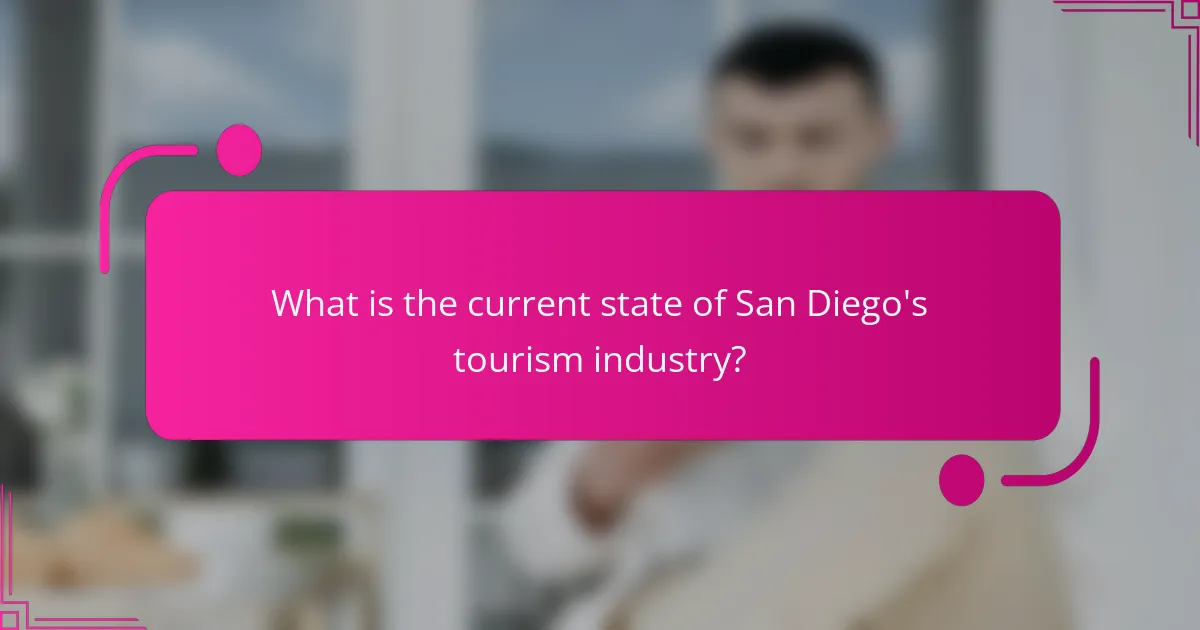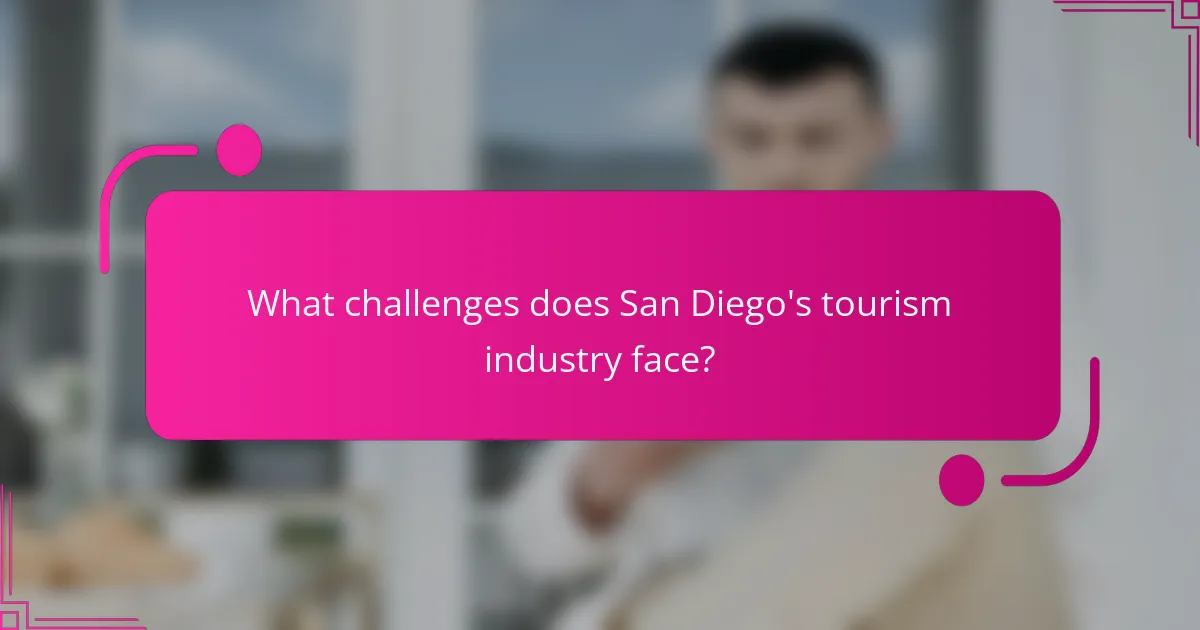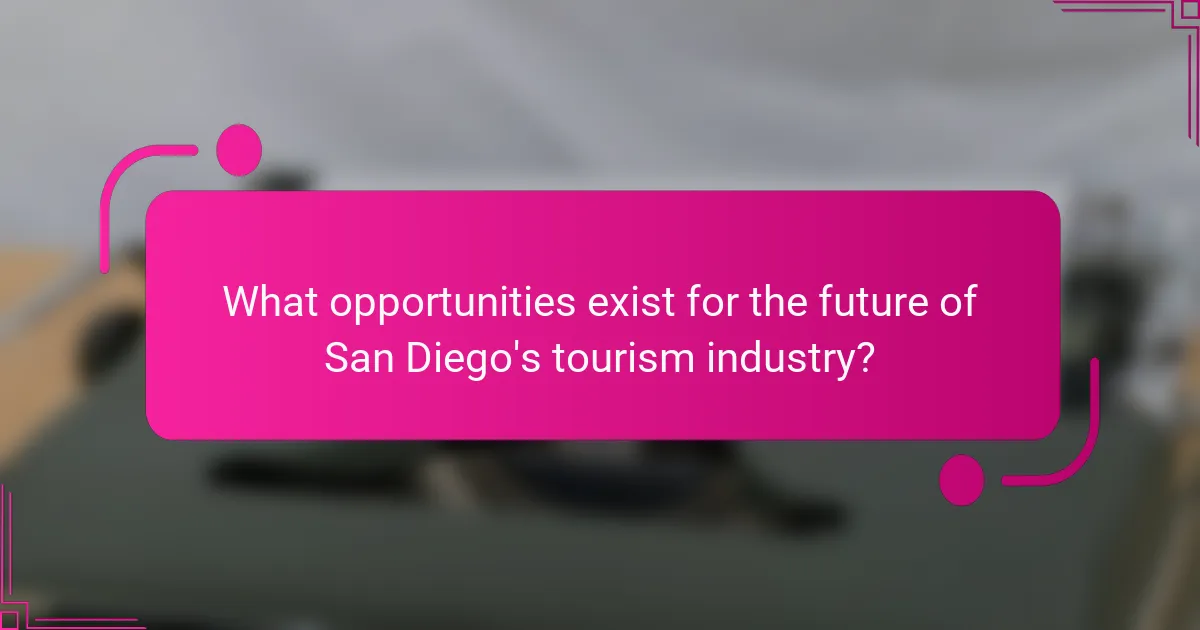
What is the current state of San Diego’s tourism industry?
San Diego’s tourism industry is experiencing a strong recovery post-pandemic. Visitor numbers have rebounded significantly, with over 35 million tourists in 2022. This figure reflects a nearly 80% recovery to pre-pandemic levels. Hotel occupancy rates have also improved, averaging around 75%. Attractions and events have resumed, drawing both domestic and international visitors. The city’s diverse offerings, including beaches, parks, and cultural sites, continue to attract tourists. Economic contributions from tourism remain vital, generating billions in revenue for the local economy. San Diego’s tourism sector shows resilience and adaptability amidst ongoing challenges.
How has the tourism landscape in San Diego evolved over the years?
The tourism landscape in San Diego has evolved significantly over the years. Initially, it focused on beach tourism and military attractions. In the 1960s, the establishment of SeaWorld and the San Diego Zoo expanded the appeal. The 1980s saw a rise in conventions and business travel with the construction of the San Diego Convention Center. In recent years, there has been a shift towards eco-tourism and cultural experiences. The COVID-19 pandemic in 2020 led to a temporary decline in tourism, but recovery has begun with a focus on safety and outdoor activities. Current trends indicate a growing interest in sustainable travel options and local experiences. Overall, San Diego’s tourism has diversified, adapting to changing consumer preferences and global events.
What historical factors have influenced tourism in San Diego?
Tourism in San Diego has been influenced by several historical factors. The establishment of the city in 1769 marked the beginning of its development as a key port. The arrival of the railroad in the late 19th century facilitated access to the region. San Diego’s climate and beaches attracted visitors throughout the early 20th century. The 1915 Panama-California Exposition showcased the city’s attractions and culture. Military presence during World War II brought an influx of visitors and economic growth. Post-war developments, including the creation of attractions like SeaWorld and the San Diego Zoo, further enhanced tourism. The city’s cultural diversity and events, such as Comic-Con, have also drawn tourists in recent decades. These historical factors have collectively shaped San Diego into a prominent tourist destination.
How have visitor demographics changed in recent years?
Visitor demographics in San Diego have shifted significantly in recent years. There has been an increase in younger travelers, particularly millennials and Gen Z. These groups are drawn to unique experiences and digital engagement. Additionally, international visitors have diversified, with more tourists from Asia and Latin America. The rise of remote work has led to longer stays from domestic travelers. Data from the San Diego Tourism Authority indicates a 15% increase in visitors aged 18-34 since 2019. Moreover, the overall visitor profile now reflects a greater emphasis on sustainability and local culture.
What are the key trends shaping the future of San Diego’s tourism industry?
Key trends shaping the future of San Diego’s tourism industry include increased focus on sustainability, technology integration, and experiential travel. The tourism sector is moving towards eco-friendly practices to attract environmentally conscious travelers. San Diego’s hotels and attractions are adopting green certifications and reducing waste. Technology is enhancing visitor experiences through mobile apps and virtual tours. These tools provide convenience and personalized interactions. Additionally, travelers are seeking unique, immersive experiences that connect them with local culture. This trend promotes local businesses and fosters community engagement. According to a recent study, 70% of tourists prefer experiences over traditional sightseeing. This shift indicates a significant change in consumer preferences within the tourism market.
How is technology impacting tourism experiences in San Diego?
Technology significantly enhances tourism experiences in San Diego. It provides visitors with easy access to information through mobile apps and websites. Tourists can explore attractions, restaurants, and events in real-time. Virtual reality tours allow potential visitors to preview experiences before arrival. Additionally, augmented reality features enrich on-site experiences by providing interactive content. Smart transportation solutions, such as ride-sharing apps, streamline travel around the city. Data analytics helps businesses tailor services to meet tourist preferences. According to a report by the San Diego Tourism Authority, technology adoption has increased visitor satisfaction rates by 25%.
What role does sustainability play in future tourism trends?
Sustainability plays a crucial role in shaping future tourism trends. It addresses environmental concerns and promotes responsible travel practices. Tourists increasingly prefer eco-friendly options that minimize their carbon footprint. According to a 2021 Booking.com survey, 81% of travelers want to stay in sustainable accommodations. This shift influences how destinations market themselves and develop tourism strategies. Cities like San Diego are investing in sustainable infrastructure to attract eco-conscious visitors. Sustainable tourism practices can enhance local economies while preserving natural resources. Therefore, sustainability is not just a trend but a fundamental aspect of future tourism development.

What challenges does San Diego’s tourism industry face?
San Diego’s tourism industry faces several significant challenges. One major challenge is the impact of seasonal fluctuations in visitor numbers. During off-peak seasons, local businesses experience reduced revenue. Another challenge is competition from other tourist destinations, which can draw potential visitors away from San Diego. Economic factors, such as inflation and rising costs, also affect tourism spending. Additionally, environmental concerns, including climate change and natural disasters, pose risks to attractions and infrastructure. The COVID-19 pandemic has further complicated recovery efforts, leading to ongoing health and safety concerns among travelers. Finally, workforce shortages in the hospitality sector hinder service quality and operational capacity.
How has the COVID-19 pandemic affected tourism in San Diego?
The COVID-19 pandemic significantly impacted tourism in San Diego. Visitor numbers dropped drastically due to travel restrictions. In 2020, tourism revenue in San Diego fell by approximately 60%. Hotels reported occupancy rates below 30%. Attractions closed or operated at reduced capacity. Many events were canceled, leading to further declines in visitor spending. The pandemic forced a shift towards outdoor and safe travel experiences. Recovery efforts are ongoing as restrictions ease and vaccination rates increase.
What are the long-term implications of the pandemic on visitor numbers?
The long-term implications of the pandemic on visitor numbers include a significant decline in overall tourism. Visitor numbers in San Diego dropped by over 50% during peak pandemic periods. Recovery is expected to be gradual, with projections indicating a return to pre-pandemic levels by 2024 or later. Changes in travel behavior, such as increased preference for outdoor activities, will influence future visitor patterns. Additionally, health and safety concerns may lead to sustained lower capacity in attractions and accommodations. A shift towards domestic tourism is also anticipated, as international travel remains uncertain. These trends suggest a long-lasting impact on the tourism landscape in San Diego.
How is the industry adapting to changing health and safety regulations?
The industry is adapting to changing health and safety regulations by implementing enhanced sanitation protocols. Businesses have adopted rigorous cleaning procedures in response to new guidelines. Many establishments now use hospital-grade disinfectants to ensure safety. Contactless technology has been integrated to minimize person-to-person interactions. Training programs for staff on health compliance have become standard practice. The industry is also closely monitoring local and federal regulations to remain compliant. Data from the CDC shows that adherence to these guidelines reduces the risk of infection. Overall, these adaptations are aimed at building consumer confidence and ensuring public safety.
What economic challenges are impacting San Diego’s tourism sector?
San Diego’s tourism sector is facing several economic challenges. High inflation rates are increasing costs for both travelers and businesses. Rising prices for accommodations and dining are deterring some potential visitors. Additionally, labor shortages are impacting service quality in the hospitality industry. This shortage is partly due to increased competition for workers across various sectors. Fluctuations in gas prices are also affecting travel decisions, as higher fuel costs can deter road trips. Furthermore, global economic uncertainties are influencing international travel patterns. These factors collectively threaten the recovery and growth of San Diego’s tourism sector.
How do fluctuations in the economy affect tourism spending?
Fluctuations in the economy significantly affect tourism spending. During economic downturns, consumers tend to cut back on discretionary spending, including travel. This results in reduced hotel bookings, fewer dining experiences, and lower spending on activities. For instance, during the 2008 financial crisis, U.S. tourism spending dropped by approximately 10%. Conversely, when the economy is strong, tourism spending increases as consumers have more disposable income. In 2019, before the pandemic, U.S. travel spending reached a record $1 trillion, reflecting a robust economy. Therefore, economic conditions directly influence consumer behavior and tourism expenditure patterns.
What are the implications of rising costs for travelers and businesses?
Rising costs for travelers and businesses lead to reduced travel demand and increased operational expenses. Travelers may limit their trips due to higher prices for accommodations, transportation, and activities. This results in shorter stays or alternative travel destinations. Businesses face tighter profit margins as they absorb increased costs or pass them on to consumers. According to a recent report by the U.S. Travel Association, a 10% increase in travel costs can reduce travel spending by up to 5%. Additionally, businesses may struggle to attract customers, impacting overall revenue and growth.

What opportunities exist for the future of San Diego’s tourism industry?
San Diego’s tourism industry has significant opportunities for growth and innovation. The city’s diverse attractions, including beaches, parks, and cultural sites, can be leveraged for eco-tourism and sustainable travel experiences. The increasing popularity of wellness tourism presents a chance to create health-focused retreats and activities. Advancements in technology enable enhanced visitor experiences through virtual reality tours and mobile applications. Additionally, hosting major events, such as conventions and festivals, can attract more visitors and boost local businesses. The rise of remote work allows for extended stays, providing opportunities for vacation rentals and long-term tourism. Collaborations with local businesses can create unique packages that enhance the overall visitor experience. These factors position San Diego’s tourism industry for a promising future.
How can San Diego leverage its unique attractions to boost tourism?
San Diego can leverage its unique attractions by enhancing marketing efforts and developing tailored experiences. The city boasts iconic sites like Balboa Park and the San Diego Zoo, which draw millions annually. Promoting these attractions through targeted campaigns can increase visibility. Collaborating with local businesses for package deals can enhance visitor experiences. Additionally, hosting events around these attractions can create buzz and attract diverse audiences. For instance, the annual Comic-Con International highlights San Diego’s cultural appeal. By emphasizing its unique offerings, San Diego can position itself as a premier travel destination.
What new attractions or developments are planned for the future?
San Diego plans to introduce several new attractions and developments in the near future. The city is set to expand its waterfront parks and recreational spaces. A new aquarium is also planned to enhance marine education and conservation efforts. Additionally, there will be upgrades to existing attractions like Balboa Park and the San Diego Zoo. These developments aim to improve visitor experiences and attract more tourists. The planned projects are part of a broader strategy to boost the local economy through tourism. San Diego’s tourism board has outlined these initiatives in their latest development report.
How can partnerships with local businesses enhance the tourism experience?
Partnerships with local businesses can significantly enhance the tourism experience by providing unique, authentic offerings. These collaborations often lead to exclusive tours, local cuisine, and cultural experiences that tourists seek. Local businesses can offer personalized services that larger chains cannot replicate. This fosters a sense of community and connection for visitors. Research shows that 78% of travelers prefer to engage with local businesses during their trips. By promoting local artisans and eateries, partnerships can create a more immersive experience. Additionally, local businesses often have insights into hidden gems and off-the-beaten-path attractions. This enriches the overall travel experience and encourages longer stays.
What role does marketing play in promoting San Diego as a tourist destination?
Marketing plays a crucial role in promoting San Diego as a tourist destination. It creates awareness about the city’s attractions, events, and experiences. Effective marketing strategies highlight San Diego’s unique offerings, such as its beaches, parks, and cultural festivals. Campaigns often utilize digital platforms to reach a broader audience. Social media marketing engages potential visitors with visually appealing content. Collaborations with travel influencers further enhance visibility. Research shows that targeted marketing can increase tourist interest and visitation rates. For example, San Diego Tourism Authority reported a 4% increase in visitors due to recent marketing efforts. Overall, marketing shapes perceptions and drives tourism growth in San Diego.
How can digital marketing strategies improve visibility for San Diego tourism?
Digital marketing strategies can significantly improve visibility for San Diego tourism. These strategies include search engine optimization (SEO), social media marketing, and targeted advertising. SEO enhances online presence by optimizing content for search engines. This leads to higher rankings in search results, increasing organic traffic to tourism websites. Social media marketing engages potential visitors through platforms like Instagram and Facebook. This approach showcases San Diego’s attractions visually, driving interest and engagement. Targeted advertising allows for reaching specific demographics interested in travel. This can result in higher conversion rates for bookings and inquiries. According to a report by the San Diego Tourism Authority, digital marketing efforts have led to a 25% increase in online engagement over the past year. This data highlights the effectiveness of these strategies in boosting visibility.
What are effective ways to engage potential visitors through social media?
Effective ways to engage potential visitors through social media include creating interactive content, utilizing user-generated content, and hosting live events. Interactive content, such as polls and quizzes, encourages participation and feedback. User-generated content showcases authentic experiences from past visitors, building trust and relatability. Hosting live events, like virtual tours or Q&A sessions, fosters real-time engagement and connection. Statistics show that posts with interactive elements can increase engagement rates by up to 80%. Additionally, user-generated content can lead to a 28% increase in engagement compared to brand-generated content. These methods enhance visibility and foster community among potential visitors.
What practical strategies can stakeholders implement to enhance tourism in San Diego?
Stakeholders can enhance tourism in San Diego by developing diverse attractions and improving infrastructure. Expanding cultural events and festivals can draw more visitors. Collaborating with local businesses can create unique packages for tourists. Enhancing public transportation options can make it easier for tourists to explore the city. Promoting eco-friendly tourism initiatives can attract environmentally conscious travelers. Investing in marketing campaigns that highlight San Diego’s unique offerings can increase visibility. Engaging with community feedback can ensure that tourism strategies align with local interests. These strategies are supported by San Diego’s growing tourism statistics, which indicate a steady increase in visitor numbers over recent years.
How can local businesses collaborate to create a cohesive tourism experience?
Local businesses can collaborate to create a cohesive tourism experience by forming partnerships and sharing resources. These collaborations can include joint marketing efforts that promote local attractions, restaurants, and services together. For example, businesses can create bundled offers or packages that encourage tourists to explore multiple venues.
Additionally, local businesses can establish a shared online platform to provide tourists with comprehensive information about available services and events. This platform can enhance visibility and accessibility for tourists.
Regular meetings among local business owners can facilitate the exchange of ideas and strategies to improve the tourist experience. Collaborative events, such as festivals or markets, can also draw visitors and showcase local culture.
Research shows that communities with strong business collaborations see increased tourist satisfaction and longer stays. In San Diego, local businesses that work together can create a more inviting and engaging environment for visitors.
What best practices should be adopted to ensure sustainable tourism growth?
Adopting best practices for sustainable tourism growth involves implementing eco-friendly policies and community engagement. Eco-friendly practices include reducing waste, conserving energy, and using sustainable resources. Community engagement ensures that local cultures and economies benefit from tourism. This can be achieved through partnerships with local businesses and organizations. Additionally, promoting responsible travel behaviors among tourists is essential. Educating visitors about local customs and environmental conservation fosters respect for the destination. According to the United Nations World Tourism Organization, sustainable tourism can enhance visitor experiences while preserving natural and cultural resources for future generations.
The main entity of this article is San Diego’s tourism industry. The article provides an overview of the current state of tourism in San Diego, highlighting a strong recovery post-pandemic with over 35 million visitors in 2022 and improved hotel occupancy rates. It discusses the evolution of the tourism landscape, key trends such as sustainability and technology integration, and the changing demographics of visitors. Additionally, the article addresses challenges faced by the industry, including economic fluctuations and the impact of the COVID-19 pandemic, while also exploring opportunities for future growth and collaboration among local businesses.